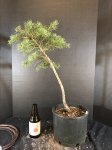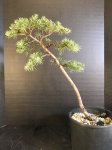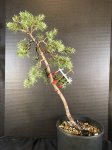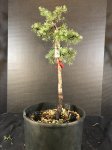Josh88
Shohin

 I found this mountain hemlock early this spring hiding in the corner of a local nursery. It had been shaded out by its neighbors for along time, and I took it home with plans of trying a literati/slant style. First pic is as purchased. It grew quite well this season not being shaded out. I put it on the bench last night to look at it for a while and decided to give it some initial direction. I found limited options in picking a front as most angles hid what little movement there is in the lower trunk, and a few branches crossed the trunk with no real hope of correction, so Inhad to hide that or get rid of them, and at many angles it leaned away from the viewer. I thinned the apex but did not wire or cut too much there, as I want to sit with that a little longer before making my choices. Thoughts, advice, and critiques are most welcome.
I found this mountain hemlock early this spring hiding in the corner of a local nursery. It had been shaded out by its neighbors for along time, and I took it home with plans of trying a literati/slant style. First pic is as purchased. It grew quite well this season not being shaded out. I put it on the bench last night to look at it for a while and decided to give it some initial direction. I found limited options in picking a front as most angles hid what little movement there is in the lower trunk, and a few branches crossed the trunk with no real hope of correction, so Inhad to hide that or get rid of them, and at many angles it leaned away from the viewer. I thinned the apex but did not wire or cut too much there, as I want to sit with that a little longer before making my choices. Thoughts, advice, and critiques are most welcome.Josh





